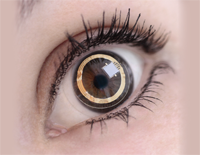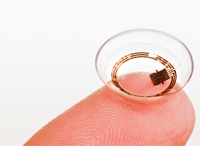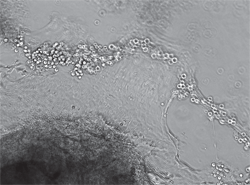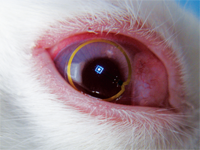More than 24 million Americans wear contact lenses—but we could see that number skyrocket even higher with the advent of contact lenses that do more than offer vision correction.1 Imagine a day when you could use contact lenses to monitor and deliver medication to your glaucoma patients, or treat your allergy or dry eye patients. Better yet, imagine if you were able to repair a damaged cornea and restore vision noninvasively by using stem cells embedded on a contact lens.

1. Sensimed’s Triggerfish lens features highly sensitive platinum strain gauges that record changes in corneal curvature that correspond directly with intraocular pressure.
You won’t have to stretch your imagination too far because researchers are already developing unique contact lens designs that could achieve those aims and more. In a few years, you might even find yourself fitting contact lenses on patients with perfectly healthy vision who aren’t in need of any correction, but rather are looking for convenience. As technological advancements continue to revolutionize the contact lens industry, these visions will soon become realities.
Disease Monitoring
In recent years, several researchers have been looking into whether contact lenses could provide a noninvasive means of monitoring blood glucose levels or intraocular pressure that improves comfort and convenience without sacrificing accuracy.
• Blood glucose. A professor at the University of Western Ontario has been developing a contact lens to measure glucose levels using tear film on the eye.2 The lens contains nanoparticles that give it a reddish hue when exposed to a certain concentration of glucose, which would alert wearers to adjust their blood sugar.2
The lenses have been successfully tested in the lab using artificial tears, but there’s still much work to be done—including developing a portable reader to provide specific measurements and an understanding of the connection between glucose levels in tears and in the blood.2
A Seattle researcher took a slightly different approach to diabetes detection, creating a contact lens prototype that utilizes LED lights.3
Using sets of electrodes, it runs tiny currents through the tear fluid and measures them to detect very small quantities of dissolved sugar. Preliminary tests suggest that the sensors can accurately detect even very low glucose levels.3 The design would also call for a portable device to be worn by the patient that would wirelessly receive information from the contact lens, allowing the patient to adjust their medication and diet as necessary.3

2. The Triggerfish lens transmits wireless measurements at regular intervals to a portable recording device worn by the patient.
This information allows doctors to schedule medication more appropriately for better IOP control. In November 2011, the company completed its first U.S. clinical study, and recruitment for a second currently is underway.4,5
Drug Delivery
In addition to looking for a more effective means of monitoring, the eye care industry has long been seeking techniques to optimize drug delivery for the treatment of chronic eye diseases, such as cataracts, glaucoma and age-related macular degeneration. Topical eye drops are one of the most frequently used treatments, but they can be cumbersome and inefficient. Some users have difficulty instilling drops because of the way the bottles are designed. In these cases, the medicine often flows away from the eye, draining into the nasal cavity and then entering the bloodstream, which can lead to drug waste and unwanted side effects.6
For years, researchers have been particularly interested in using contact lenses as a delivery vehicle for various classes of ophthalmic drugs. With advances in lens design and the availability of new polymers, it’s becoming a more realistic option.6 One new technique involves mixing the medication with a pre-polymer liquid, and then polymerizing the combination to create a transparent contact lens coating.7 This new approach has shown great promise in contact lens drug delivery devices, but its effect depends on the drug’s solubility.
If the drug is water-soluble, it will be trapped within a network of tiny, interconnected, water-filled channels in the material. If the drug is water-insoluble, it will be trapped within nano-spaces in the polymer matrix, and slowly filter out into the channels.7 Upon contact with fluid on the eyeball, these channels will open, releasing the drug. By varying the water content, the channel size can be adjusted, and the rate at which the drug is dispensed onto the eye can be controlled.8
One major obstacle eye care professionals have faced with such lenses in the past is how to ensure that sufficient oxygen gets through to the eye. Otherwise, neovascular blood vessel growth can occur. With its interconnected channels, the nanostructure of the new lenses allows gases, salts and nutrients to travel easily across the contact lens barrier.7 After testing the nano-engineered lenses to release a water-soluble glaucoma medication and a water-insoluble antibiotic onto the cornea, a research team was able to sustain controlled drug release over a few hours and even a few days.7
Ideally, these drug-eluting contact lenses eventually would be available in daily, two-week and monthly lenses so that patients could receive effective, controlled doses of medication while maintaining vision correction. Using a model of drug delivery like this could increase treatment compliance and stabilization of many ocular diseases that our patients encounter.
Stem Cell-Coated Lenses
Taking a step into uncharted territory, scientists in Australia have been looking into the possibility of using a contact lens to restore vision in patients with blindness caused by corneal damage. Researchers at the University of New South Wales infused a contact lens with a patient’s own stem cells (figure 3)––an idea that came about from the observation that stem cells from the cornea stick to contact lenses.9 They took three subjects who were blind in one eye, then obtained stem cells from their healthy eyes and cultured them in extended wear contact lenses for 10 days. Next, they cleaned the surfaces of the patients’ corneas and inserted the contact lenses.

3. Stem cells, such as these, have been cultured on a common therapeutic contact lens in order to repair corneal damage. Photo: Nick Di Girolamo, Ph.D.
Within 10 to 14 days, the stem cells began to recolonize and repair the cornea.9 Two of the three patients went from being legally blind to being able to read some of the eye chart. The third patient actually regained enough sight to pass a driving exam. Researchers are still monitoring the stability of the treatment, but the early results seem promising. The simplicity and low cost of the technique also means that it could be utilized in poorer countries. If the stem cell corneal method shows additional potential, the procedure could open doors in the future so that patients with compromised ocular structures may not have to wait for a donor.
Photochromic CLs
Patients even may be able to avoid eye damage before it happens by using contact lenses with UV protection. Long-term exposure to UV radiation can lead to cataracts, skin cancers around the eyelids, and other eye disorders. Adapting the flexibility of UV protection into contact lenses by adding a photochromic effect could benefit many patients who find sunglasses to be a nuisance. (Many contacts already have UV protection in them.)
Conventional light-responsive sunglasses (such as Transitions) are coated with millions of molecules of photochromic dyes, which are transparent when out of the sun.10
These molecules change shape when exposed to sunlight, which allows them to absorb the UV radiation, triggering a response that darkens the lens. When UV light disappears, the molecules return to their original shape and transparent appearance.
Attempts have been made to design similar light-responsive contact lenses; however, the struggle of applying a dye coating uniformly along the surface of the lens has proven difficult. Researchers at the Institute for Bioengineering and Nanotechnology in Singapore have managed to overcome this hurdle and successfully develop photochromic contact lenses that darken when exposed to UV light and return to normal in its absence.10
They contain an intricate network of nano-sized tunnels that can be filled with dyes and transition in 10 to 20 seconds—faster than light-sensitive sunglasses on the market today, according to preliminary studies the researchers have conducted.10 The team is currently working to make the lenses commercially available.
Electronic Viewing
One of the most exciting uses of contact lenses is the addition of augmented reality on top of our regular vision, which combines real and virtual surroundings to create an “integrated world.” Containing hundreds of LEDs, these lenses would form images in front of the eye that integrate words, photographs and diagrams so that wearers can navigate their
surroundings and view displayable information through their contact lenses—much like Arnold Schwarzenegger’s character in “The Terminator” movies and, more recently, as seen in “Mission: Impossible Ghost Protocol.”

4. Placed on the eye of a live rabbit, this contact lens display is powered by a dipole antenna, showing bright emission from the on-lens pixel.
Photo: Babak Parviz, Ph.D., M.S.
While it may seem like science fiction, such bionic technology is much closer to becoming a reality than you might think. Researchers at the University of Washington have created semi-transparent contact lenses with built-in electronics, control and communication circuits, and miniature antennas.11
They tested a single-pixel, wireless contact lens display on live, anesthetized rabbits and found no adverse effects (figure 4).11 Lead researcher Babak Parviz, Ph.D., M.S., suggests that even a lens with a single pixel could aid individuals with hearing impairments.12 Furthermore, with the addition of color and increased resolution, he believes it could translate into speech captions, visual cues and displayed texts.12
Challenges
Advances in contact lens technology take considerable time. For a new refractive error lens to reach the market, it must go through a stringent research and development process in addition to rigorous studies and trials. This process will be even more significant for lenses geared toward applications beyond vision correction.
Variables, such as lens temperature, oxygen/water content and duration of wear time, should be considered for the safety of the patient. It will take additional efforts, including further scientific research, testing and development, to ensure that they meet the same health and safety standards as current lenses.
As eye care providers, such advances could bolster our practices and improve our reach by increasing the market for contact lens wearers. As these changes come about, it’s crucial that we maintain our stance that any contact lens is a medical device that needs to be fitted by a trained eye care professional to ensure the highest level of safety for patients and their eye health.
If we look at our current patient base, we can readily see how contact lenses change lives daily––from the patient who has keratoconus to the child who plays sports. They are integral to improving vision and, in many cases, quality of life.
Dr. Kading owns Specialty Eyecare Group, a Seattle-based practice with multiple locations. His emphasis is on specialty contact lenses and new technologies. Dr. Shen is an associate at Specialty Eyecare Group where she specializes in pediatrics, binocular vision and ocular pathology.
1. University of Michigan Kellogg Eye Center. Contact Lenses. Available at:
www.kellogg.umich.edu/patientcare/conditions/contact.lenses.html. (accessed December 28, 2011).
2. Collier R. Rosy outlook for people with diabetes. CMAJ. 2010 March 23;182(5):E235-6.
3. Graham-Rowe D. Smart contact lenses for health and head-up displays. New Scientist. 2011 January 10; 2794:18-9.
4. Medeiros F. SENSIMED Triggerfish safety and tolerability. In: ClinicalTrials.gov [Internet]. Bethesda, MD: National Library of Medicine. 2011. NLM Identifier: NCT01319617. Available at:
http://clinicaltrials.gov/ct2/show/NCT01319617 (accessed December 28, 2011).
5. Liu JHK. Efficacy of 24-hour intraocular pressure fluctuation recording with the SENSIMED Triggerfish contact lens sensor. In: ClinicalTrials.gov [Internet]. Bethesda, MD: National Library of Medicine. 2011. NLM Identifier: NCT01390779. Available at:
http://clinicaltrials.gov/ct2/show/NCT01390779 (accessed December 28, 2011).
6. Singh K, Nair AB, Kumar A, Kumria R. Novel approaches in formulation and drug delivery using contact lenses. J Bas Clin Pharm. 2011 May;2(2):87-101.
7. Young E. Drug-delivering contact lenses revealed. New Scientist. October 29, 2004. Available at:
www.newscientist.com/article/dn6597-drugdelivering-contact-lenses-revealed.html (accessed December 28, 2011).
8. Gulsen D, Chauhan A. Ophthalmic drug delivery through contact lenses. Invest Opthalmol Vis Sci. July 2004; 45(7):2342-7.
9. Di Girolamo N, Bosch M, Zamora K, et al. A contact lens-based technique for expansion and transplantation of autologous epithelial progenitors for ocular surface reconstruction. Transplantation. 2009 May 27;87(10):1571-8.
10. Chu J. Contact lenses that respond to light. Technology Review. 2009 November 10. Available at:
www.technologyreview.com/biomedicine/23922 (accessed December 28, 2011).
11. Lingley AR, Ali M, Liao Y, et al. A single-pixel wireless contact lens display. J Micromech Microeng. 2011;21(12):1-8.
12. Parviz BA. Augmented reality in a contact lens. IEEE Spectrum. Available at:
http://spectrum.ieee.org/biomedical/bionics/augmented-reality-in-a-contact-lens (accessed December 27, 2011).

